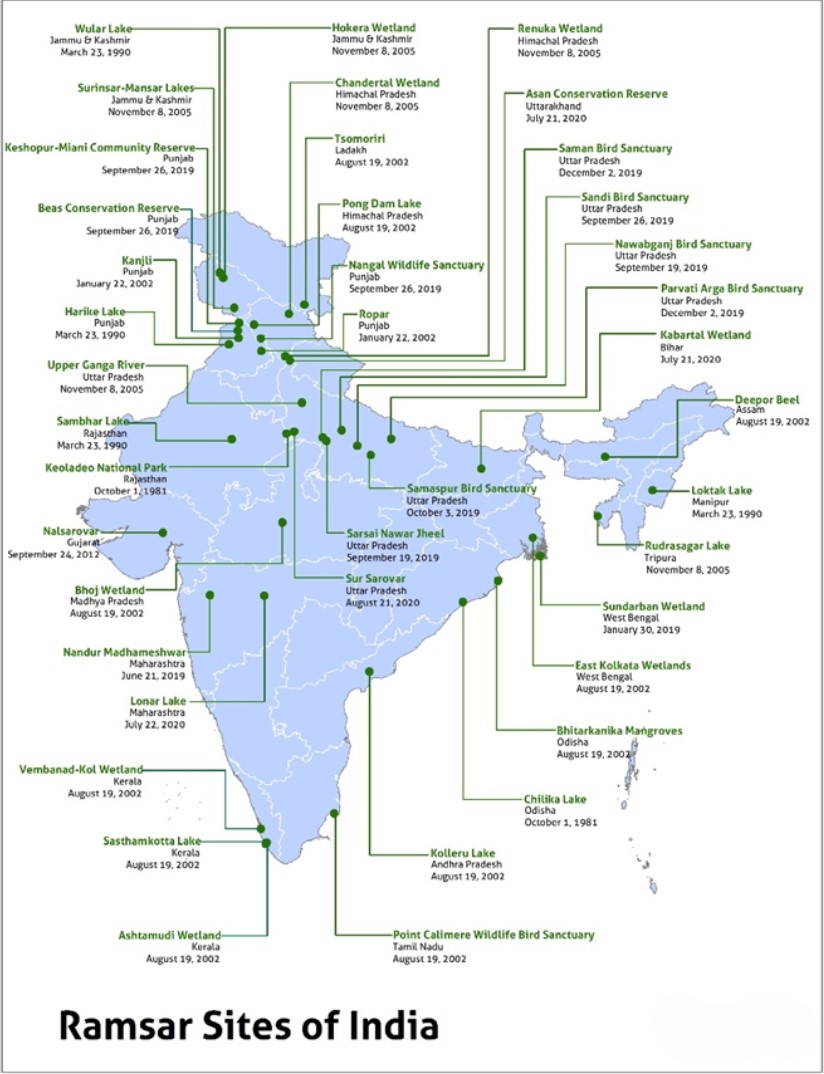About
- The ‘Amrit Dharohar Capacity Building Scheme‘ is a collaborative effort between the Ministry of Tourism and the Ministry of Environment, Forest, and Climate Change.
- The scheme will be implemented over the next three years (2023 onwards) to encourage optimal use of wetlands and enhance biodiversity, carbon stock, eco-tourism opportunities, and income generation for local communities.
- The primary focus of the Scheme is to strategically transition from high-volume tourism to high-value nature tourism at ecologically sensitive wetlands.
Aim
The aim is to enhance livelihood opportunities for local communities through harnessing the nature-tourism potential of the Ramsar Sites across the country.
Implementation
The scheme is being implemented in convergence with various Central Government ministries and agencies, State wetland authorities, and a network of formal and informal institutions and individuals, working together for a common cause.
Pilot Projects and Skill Development
- Out of 16 identified Ramsar sites, five have been selected for pilot projects under the scheme.
- These pilot sites include Sultanpur National Park (Haryana), Bhitarkanika Mangroves (Odisha), Chilika Lake (Odisha), Sirpur (Madhya Pradesh), and Yashwant Sagar (Madhya Pradesh).
- Training programs for participants are carried under the Alternative Livelihood Programme (ALP) (a 30 hours/15 days training programme) and Paryatan Navik Certificate (boatman certification for tourism).
What is a Ramsar Site
- A Ramsar site is a wetland designated to be of international importance under an environmental treaty signed in February 1971 at Ramsar, Iran under the auspices of UNESCO.
- Ramsar provides for national action and international cooperation regarding the conservation of wetlands, and wise sustainable use of their resources.
- India has 75 Ramsar sites.
Functions of Wetlands
Wetlands play a crucial role in sustaining ecosystems and providing a myriad of values and benefits. Here’s an in-depth look at the various functions they perform and the advantages they offer:
Source of Water:
Wetlands are a primary source of fresh water, with aquifer-stored groundwater constituting over 95 percent of all available freshwater. They aid in rainwater absorption, groundwater recharge, and serve domestic, irrigation, and drinking water needs.
Flood and Storm Buffer Zone:
Acting as natural buffers, wetlands alleviate droughts and mitigate floods. They function as sponges, absorbing rainfall and snowmelt, allowing water to gently percolate into the soil. Coastal wetlands, including mangroves and coral reefs, act as physical barriers against storm surges and tidal waves.
Wetland Products:
Coastal wetlands contribute over two-thirds of the global fish supply, a crucial source of animal protein. Well-managed wetlands supply a diverse range of plants, animals, and minerals. They play a vital role in rice production, and many, like the Sundarbans, produce honey and other valuable products.
Water Purifier:
Wetlands aid in water purification by trapping contaminants in sediments and plants. They significantly lower pollutant levels, such as phosphorus and nitrogen from agricultural runoff. Certain wetland plants can eliminate harmful compounds from pesticides, industrial discharge, and mining.
Wetland for Research and Education:
Wetlands serve as excellent sites for learning about aquatic ecosystems and conducting research. Their habitat diversity, ecosystem complexity, and cultural ties make them ideal for multi-disciplinary studies. Examples include the Bhitarkanika Mangroves in Odisha and Bhoj Wetlands in Madhya Pradesh.
Recreation Property of Wetlands:
Wetlands offer relaxation and tourism opportunities due to their natural beauty and diverse plant and animal life. Locations like Mandawali village in NCT Delhi serve as recreational sites.
Combat Climate Change:
Wetlands, including mangroves and salt marshes, operate as carbon sinks, preventing greenhouse gas emissions. They play a crucial role in moderating and adapting to climate change. Wetland conservation is vital for protecting aquatic habitats threatened by climate change.
Habitats of Migratory Birds:
Migrating birds use wetlands as feeding, resting, and nesting stopovers. Indian wetlands, like Bakhira Wildlife Sanctuary and Ashtamudi Wetlands, are essential components of the Central Asian and East Australasian Flyways.
Biodiversity Hotspots:
Several wetlands serve as habitats for a variety of endemic and near-endangered species. Examples include Kaziranga National Park for the Great Indian Rhinoceros and Keibul Lamjao for the Brow-antlered Deer. Chilika Lake is home to endangered Irrawaddy Dolphins, and Koonthankulam Bird Sanctuary in Tamil Nadu.



